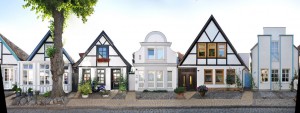Amsterdam [Yiddish: Mokum], first mentioned as Aemstelredamme in 1275, situated centrally in the Netherlands on the mouth of the Amstel and the Ij into the Ijsselmeer, largest city of the Netherlands, 41st largest city in Europe.
Population: 826.000 (2015) | 695.000 (1990) | 757.000 (1930) | 524.000 (1900)
Amsterdam is the capital of the Netherlands, but not the seat of its parliament (Den Haag). It is known worldwide for its canal system, the so-called Grachtengordel, and its architecture (also an UNESCO world heritage site). In the 17th century, the Dutch Golden Age, it was probably the wealthiest city in the world. The offices of the East India Trading Company became the first stock exchange in the world in 1602. It was also for centuries a safe haven for europe’s jews and they called it the „Jerusalem of the West“. Anne Frank lived in Amsterdam. Today Amsterdam is home to several world renowned museums.
This night view of the Oudezijds Voorburgwal depicts the typical dutch gabled houses along Amsterdam’s canals. It lies within the De Wallen district of central Amsterdam and is also part of Amsterdams Red Light District (dutch Rosse Buurt), as can obviously be seen with some of the red windows and sex shops here. The Oudezijds Voorburgwal is one of the most frequented canals in Amsterdam and one can find more than a hundred national listed buildings along it, including De Oude Kerk, Amsterdam’s oldest church. This view of the iced canal is relatively rare and was taken in february 2012.
Visit our archive for more streetline panoramas from Amsterdam.
Click for larger view:
For classic view and further details visit the archive:











